-
 Iron tsuba of mokko form decorated with brass flat inlay (hira-zōgan) all over on both sits and going over the rounded rim. Black patina, well-forged iron. Hitsu-ana outlined with brass inlay. Former owner's catalogue number in red paint reads 25-17-61. Gary D. Murtha provides detailed account of this type of tsuba in Japanese Sword Guards. Onin-Heianjo-Yoshiro book on pages 118-122. He calls this type of tsuba "Heianjo Mogusa Tsuba": "The term mogusa is commonly used for an inlay design that represents an aquatic weed, similar to a duck weed or sago plant, which is known to quickly invade and overtake bodies of water. [...] Perhaps the visual image has some cross-over meaning for samurai in that, like the plant, a small aggressive samurai force could conquer a larger foe/area." I tried to find any reference to "mogusa" in literature, - to no avail. Neither on the vastness of internet, including Wikipedia... I did find the "duckweed" (one word), but visually it has nothing to do with the pattern on tsuba. "Sago plant" probably stands for 'Sago palm", and there is some very distant reminiscence in the construction of the sago palm leaf and the said design of inlay, but I would not go that far. In the old catalogues, such as Naunton and Hawkshaw collections, this pattern as called "sea weed" and/or "conventional fir". I will stick to these descriptions, tested by the time, and leave the enigmatic "mogusa" alone. Obviously, this type of tsuba has transformed into Yoshirō tsuba, both in Kaga province and Bizen province. Momoyama period (ca. 1660). Dimensions: 74.5 x 73.7 x 4.4 mm.
Iron tsuba of mokko form decorated with brass flat inlay (hira-zōgan) all over on both sits and going over the rounded rim. Black patina, well-forged iron. Hitsu-ana outlined with brass inlay. Former owner's catalogue number in red paint reads 25-17-61. Gary D. Murtha provides detailed account of this type of tsuba in Japanese Sword Guards. Onin-Heianjo-Yoshiro book on pages 118-122. He calls this type of tsuba "Heianjo Mogusa Tsuba": "The term mogusa is commonly used for an inlay design that represents an aquatic weed, similar to a duck weed or sago plant, which is known to quickly invade and overtake bodies of water. [...] Perhaps the visual image has some cross-over meaning for samurai in that, like the plant, a small aggressive samurai force could conquer a larger foe/area." I tried to find any reference to "mogusa" in literature, - to no avail. Neither on the vastness of internet, including Wikipedia... I did find the "duckweed" (one word), but visually it has nothing to do with the pattern on tsuba. "Sago plant" probably stands for 'Sago palm", and there is some very distant reminiscence in the construction of the sago palm leaf and the said design of inlay, but I would not go that far. In the old catalogues, such as Naunton and Hawkshaw collections, this pattern as called "sea weed" and/or "conventional fir". I will stick to these descriptions, tested by the time, and leave the enigmatic "mogusa" alone. Obviously, this type of tsuba has transformed into Yoshirō tsuba, both in Kaga province and Bizen province. Momoyama period (ca. 1660). Dimensions: 74.5 x 73.7 x 4.4 mm. -

-
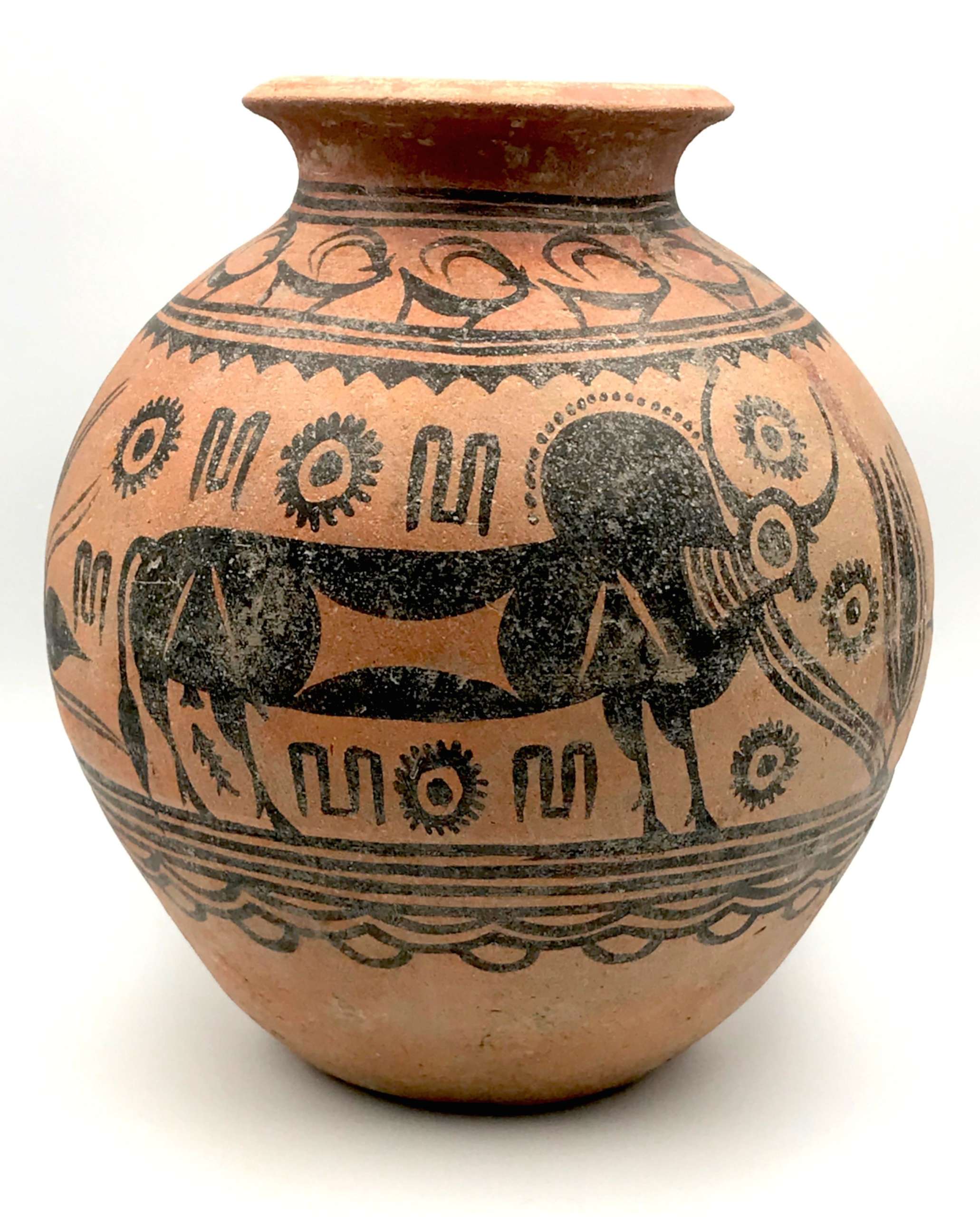 Circa 3300-2000 BC Dimensions: 184 x 165mm. Weight: 708grams
Circa 3300-2000 BC Dimensions: 184 x 165mm. Weight: 708grams -

Iron tsuba of oval form with a shakudō fukurin and rough surface decorated by low relief carving and brass inlay with a centipede emerging from under the rock on both sides.
Edo period.Size: 78.9 x 73.6 x 3.8 mm
Unsigned. However, this tsuba may be (though with reservation) attributed to Misumi Kōji school. There is some information regarding this master(s) in Tsuba. An aesthetic study by Kazutaro Torigoye and Robert E. Haynes (from the Tsuba Geijutsu-kō of Kazataro Torigoye. Edited and published by Alan L. Harvie for the Nothern California Japanese Sword Club, 1994-1997) on pages 163-4, though I was not able to locate the tsuba in the original publication. Possibly, this fragment of the book was added by Robert Haynes. Markus Sesko speculates about Misumi in his The Japanese toso-kinko Schools.// Lulu Inc., 2012 on pages 374-5: "Misumi Kōjo Tsuba. Iron plate, elliptical shape, shakudō takabori suemon, yamagane fukurin. Centipede." But of course, visual similarity does not prove anything. I was not able to find any traces of signature or a triangle on the seppa-dai.
Misumi Kōji Tsuba on p. 163.
-

Iron tsuba of mokko form with rough surface decorated in low relief carving (sukidashi-bori) and openwork (sukashi) with a flying bat, a crescent moon, and a cloud over the moon. Bat's eyes inlaid with gold. Crescent moon and cloud on the reverse. Copper sekigane. Kogai hitsu-ana plugged with shakudō.
Unsigned.
Edo period.Size: Height: 83.7 mm; Width: 80.3 mm; Thickness: 2.9 mm; Weight: 141 g.
-

Iron tsuba of elongated round form with brown (chocolate) patina. The surface is carved with file strokes (sujikai-yasurime) to imitate heavy rain. The design of a bird drinking water from a bucket hanging on a rope is carved in low relief (sukidashi-bori); the rope is inlaid in gold. The well structure on the reverse, carved in low relief. Nakago-ana is enlarged and plugged with copper sekigane. Unsigned.
Edo period.Size: Height: 75.1 mm; Width: 68.3 mm; Thickness: 4.6 mm; Weight: 134 g.
Unsigned.
SOLD -
 Mokkō form iron tsuba carved in relief and inlaid with soft metals (copper, gold, silver) with the design of a cormorant fisherman on the face and a boat on the reverse. Unsigned. Dimensions: 77 mm x 69 mm x 3.0 mm (at seppa-dai) Edo period: 18th or 19th century. "Since Nara period, Japanese fishermen in small boats have used cormorants (u) to catch river fish at night, binding the necks of the birds so that the fish are not swallowed. [...] The bird and the work it performs are symbols of selfless devotion to one's master and keen eyesight." - from Merrily Baird. Symbols of Japan. Thematic motifs in art and design. Rizzoli international publications, Inc., 2001; p. 104. See also in this collection TSU-0212 and TSU-0241.
Mokkō form iron tsuba carved in relief and inlaid with soft metals (copper, gold, silver) with the design of a cormorant fisherman on the face and a boat on the reverse. Unsigned. Dimensions: 77 mm x 69 mm x 3.0 mm (at seppa-dai) Edo period: 18th or 19th century. "Since Nara period, Japanese fishermen in small boats have used cormorants (u) to catch river fish at night, binding the necks of the birds so that the fish are not swallowed. [...] The bird and the work it performs are symbols of selfless devotion to one's master and keen eyesight." - from Merrily Baird. Symbols of Japan. Thematic motifs in art and design. Rizzoli international publications, Inc., 2001; p. 104. See also in this collection TSU-0212 and TSU-0241. -
 Iron tsuba with design of a cricket and grass inlaid in brass (suemon-zōgan) and a bridge over a stream in openwork (sukashi) on both sides. Inlay of distant part of the cricket's antenna is missing. Heianjō School. Momoyama period. Diameter: 79.5 mm, thickness at seppa-dai: 3.3 mm NBTHK # 4002100.
Iron tsuba with design of a cricket and grass inlaid in brass (suemon-zōgan) and a bridge over a stream in openwork (sukashi) on both sides. Inlay of distant part of the cricket's antenna is missing. Heianjō School. Momoyama period. Diameter: 79.5 mm, thickness at seppa-dai: 3.3 mm NBTHK # 4002100. -

Iron tsuba of round form decorated with a design of bracken scrolls and paulownia leaves and blossoms (kiri-mon) in openwork (sukashi). Details carved in kebori. Squared rim with iron bones (tekkotsu). Hitsu-ana plugged with shakudō.
Size: 83.6 x 82.9 x 5.4 (center), 5.1 (rim) mm.
Unsigned.
Muromachi period, ca. 16th century.
-

Iron tsuba pierced and carved (marubori-sukashi) with the 'horse in the round' design. Possibly, Bushū-Ito school, 19th century (ca. 1800). Kogai-hitsu-ana plugged with shakudō.
Size: 67.6 x 66.8 x 5.1 mm
Unsigned.
See:
-
- Robert E. Haynes. Study Collection of Japanese Sword Fittings. Nihon Art Publishers, 2010, p. 120: Iron plate carved and formed in the round as a tethered bull...Signed: Bushū jū Sadayasu saku.
- Robert E. Haynes. Masterpiece and highly important tsuba, etc... San Francisco, 1984 // Catalog #9.: Signed: Bushū jū Yoshifusa. Ca. 1800, H 6.7 cm, Th. 4.75 mm.
- The Hartman collection of Japanese metalwork. Christie's, 1976, p. 29, №59: Bushū type, 19th century. Reference to Takezawa, Nihon Toban Zuetsu №411 for a similar design signed Bushū Yoshifusa.
4. Japanese Sword Fittings from the R. B. Caldwell Collection. Sale LN4188 "HIGO". Sotheby's, 30th March 1994, p. 17, №24: An iron tsuba, by Heianjo Sadatsune, Edo period (18th century). In the form of a horse, standing with its head lowered and a rope halter attached to its bit and trailing beneath. Signed Heianjo Sadatsune, 7.3 cm. With NBTHK Tokubetsu kicho paper, dated Showa 49 (1974). GBP 600-700.
Hartman collection, №59.

The Caldwell Collection. Heianjo Sadatsune, Edo period (18th century).
-
-
 An iron tsuba in the shape of a bold or shaved human head in full round. Unsigned. Dimensions: 62.5 x 53.4 x 4.4 mm Iron, in the shape of a Ni O (Nio) head, in full round, the back flat chased as a pine forest. Signed : Miōchin Masatsugu in sosho. №38 in The Naunton Collection, 1912. There are a few tsuba of such design known. SOLDIron, a severed head. Signed: Takeaki of Kwaiyō. Ex Hawkshaw Collection [Plate VII]. Below written: Takurio, Suruga, 1118; Tamagawa, p. ; Tanaka, p. 168; Tanetora, 1894. №2729 in The Naunton Collection, 1912.
An iron tsuba in the shape of a bold or shaved human head in full round. Unsigned. Dimensions: 62.5 x 53.4 x 4.4 mm Iron, in the shape of a Ni O (Nio) head, in full round, the back flat chased as a pine forest. Signed : Miōchin Masatsugu in sosho. №38 in The Naunton Collection, 1912. There are a few tsuba of such design known. SOLDIron, a severed head. Signed: Takeaki of Kwaiyō. Ex Hawkshaw Collection [Plate VII]. Below written: Takurio, Suruga, 1118; Tamagawa, p. ; Tanaka, p. 168; Tanetora, 1894. №2729 in The Naunton Collection, 1912.
№38 Naunton Collection, 1912.
Reference to Hawkshaw Collection [Plate VII] happened to be not exact; it is Plate VIII, №236. It is clearly not the Hawkshaw piece (different facial expression, signle hitsu-ana, no plug. Description at Hawkshaw, 1910, reads: Iron, in the shape of a man's head, severed at the neck, the forehead in three wrinkles, the mouth hard-set and drooping, the eyes open, inlaid brass with shakudo pupils. Signed: Shoami; dated second year of Shoho, first month [SV: December 1644 through February 1648].
№2729 Naunton Collection, 1912.

№236 Hawkshaw Collection, 1910.
-
 Iron tsuba of round form with a Marsilea (water clover, paddy plant, denjiso) in openwork (sukashi) and a cricket carved in low relief (katakiribori) with extremities and one antenna inlaid with brass; the other antenna is carved in kebori (which antenna is inlaid and which is carved alternates on the face and on the reverse). The plate decorated with vertical file stroke ornamentation (tate-yasurime). Raised dam-shaped rim (dote-mimi). Inscription from a previous collector in red oil paint: 22-71-1. Edo period, possibly 17th century. Katchushi school.
Iron tsuba of round form with a Marsilea (water clover, paddy plant, denjiso) in openwork (sukashi) and a cricket carved in low relief (katakiribori) with extremities and one antenna inlaid with brass; the other antenna is carved in kebori (which antenna is inlaid and which is carved alternates on the face and on the reverse). The plate decorated with vertical file stroke ornamentation (tate-yasurime). Raised dam-shaped rim (dote-mimi). Inscription from a previous collector in red oil paint: 22-71-1. Edo period, possibly 17th century. Katchushi school.Size: 75.0 x 74.4 x 3.6 (center), 5.0 (rim) mm.
The plant Marsilea (paddy plant, denjiso), common names include water clover and four-leaf clover because the long-stalked leaves have four clover-like lobes and are either held above water or submerged. In The elements of Japanese design by John W. Dower, this motif is listed under the numbers 634-35 Paddy Plant (denjiso). Obviously, as a four-leaf clover it is an auspicious symbol. The four leaves radiate out as the shape of the kanji 田 (romaji 'ta'), which means 'rice paddy'. This symbol may be used as a family crest (mon), and this would be the most probable explanation of the sukashi on this tsuba. -
 [SOLD]
[SOLD]Iron tsuba of slightly elongated round form carved and inlaid in gold and shibuichi with a long-armed monkey hanging from a pine tree branch reaching for the reflection of a crescent moon in the stream. A pine tree carved with details inlaid in gold on the reverse. The design seems to be inspired by Kaneie work (Compton III, p. 10, №6a; Tsuba no bi, 1947, p. 33, №56).
Dimensions: 76.8 x 74.2 x 3.6 mm. Mid-Edo period. Unsigned.
Compton III, p. 10, №6a

Tsuba no bi, 1947, p. 33, №56.
-
 Iron tsuba of oval form carved and inlaid in gold and copper with cormorant fisherman in disguise. Unsigned. Dimensions: 67.7 mm x 61.5 mm x 3.8 mm (at seppa-dai) Edo period: 18th century. "Since Nara period, Japanese fishermen in small boats have used cormorants (u) to catch river fish at night, binding the necks of the birds so that the fish are not swallowed. [...] The bird and the work it performs are symbols of selfless devotion to one's master and keen eyesight." - from Merrily Baird. Symbols of Japan. Thematic motifs in art and design. Rizzoli international publications, Inc., 2001; p. 104. See also TSU-0212 and TSU-0096
Iron tsuba of oval form carved and inlaid in gold and copper with cormorant fisherman in disguise. Unsigned. Dimensions: 67.7 mm x 61.5 mm x 3.8 mm (at seppa-dai) Edo period: 18th century. "Since Nara period, Japanese fishermen in small boats have used cormorants (u) to catch river fish at night, binding the necks of the birds so that the fish are not swallowed. [...] The bird and the work it performs are symbols of selfless devotion to one's master and keen eyesight." - from Merrily Baird. Symbols of Japan. Thematic motifs in art and design. Rizzoli international publications, Inc., 2001; p. 104. See also TSU-0212 and TSU-0096 -
 Iron tsuba of otafuku-gata form decorated on the face with death and autumn motifs: autumnal grasses and flowers in yellow brass and shakudō, skull, limb bone and sternum inlaid in shakudō. On the reverse the plate is inlaid in red copper with a chrysanthemum and maple leaves floating in stylized water streams. "Plants floating atop water form common motifs, as occurs with chrysanthemums, maple leaves, and cherry blossoms, in particular." [Merrily Baird]. Such plants may be used as a family crest (mon), or may be just a reminder of a floating nature of life. Momoyama period, late 15th century. Dimensions: 75.3 x 69.9 x 4.3 mm.
Iron tsuba of otafuku-gata form decorated on the face with death and autumn motifs: autumnal grasses and flowers in yellow brass and shakudō, skull, limb bone and sternum inlaid in shakudō. On the reverse the plate is inlaid in red copper with a chrysanthemum and maple leaves floating in stylized water streams. "Plants floating atop water form common motifs, as occurs with chrysanthemums, maple leaves, and cherry blossoms, in particular." [Merrily Baird]. Such plants may be used as a family crest (mon), or may be just a reminder of a floating nature of life. Momoyama period, late 15th century. Dimensions: 75.3 x 69.9 x 4.3 mm. -

Iron tsuba of oval form decorated with design of jakago (bamboo lattice work) in openwork (sukashi). Copper sekigane.
Unsigned. Edo period.
Size: 73.7 x 70.3 x 5.6 mm.Note regarding design: though some might think that this piece belonged to a member of the lost tribe of Israel, it did not. Jakago baskets were made of bamboo, filled with rocks and used to catch crabs (besides other uses).

Jeanne Allen. Designer's Guide to Samurai Patterns. Chronicle Books, San Francisco, 1990; p.51, №57.
-

Large oval form tsuba decorated with two human figures (scholar and attendant) under the pine tree admiring a view of a waterfall on the face of the plate, and with stylized dragons carved on the reverse among the symbols of thunder inlaid in gold. The plate is carved in low relief with details inlaid with gold and silver.
Signed: Yamashiro no kuni Fushimi no ju Kaneie [Kaneie of Fushimi in Yamashiro Province] [山城國伏見住金家], with Kaō. It is a fake signature (
gimei). Size: Height: 91.9 mm; Width: 85.6 mm; Thickness: 3.4 mm; Weight: 169 g.
This is a late Edo period, 19th-century export work to cater to the tastes of the European tsuba collectors. It does not have anything in common with the work of great Kaneie masters.
SOLD -
 Iron tsuba of round form with design of slanting rays of light (shakoh) or clock gear (tokei) in openwork (sukashi). Commonly considered a Christian / Jesuit motif. Copper sekigane. According to seller, Owari School. Haynes writes that most tsuba of this design are Owari (Tsuba. Aesthetic Study). Unsigned. Edo period. According to F. Geyer, diamond-shaped vertical posts and long rays suggest that this tsuba was probably made between 1605 and 1630.
Iron tsuba of round form with design of slanting rays of light (shakoh) or clock gear (tokei) in openwork (sukashi). Commonly considered a Christian / Jesuit motif. Copper sekigane. According to seller, Owari School. Haynes writes that most tsuba of this design are Owari (Tsuba. Aesthetic Study). Unsigned. Edo period. According to F. Geyer, diamond-shaped vertical posts and long rays suggest that this tsuba was probably made between 1605 and 1630.Size: 76.9 x 76.0 x 5.4 mm
For information regarding shakoh tsuba see article 'Kirishitan Ikenie Tsuba by Fred Geyer at Kokusai Tosogu Kai; The 2nd International Convention & Exhibition, October 18-23, 2006, pp. 84-91. -

Iron tsuba of oval form pierced with design of slanting rays of light (shakoh), a Christian motif (Jesuit’s IHS symbol), and a pair of tassels in positive silhouette (ji-sukashi). Details on tassels carved in low relief. Traditional description of this kind of design is called “tokei”, or “clock gear”. Rounded rim.
Unsigned.
Edo period, 17th or 18th century. Possibly - Owari school.
Size: 76.0 x 73.0 x 6.2 mm. -
 Iron tsuba of oval form with design of a gourd or aubergine vine with fruits, leaves, and blossoms climbing a trellis, and a fence in yellow brass and red copper flat inlay (hira-zōgan); inlay engraved. Two latticed windows represented by openwork (sukashi). The iron web has deep black patina. The seller attributes this tsuba to Heianjo-Namban school, whatever it means. Momoyama or early Edo period, 17th century. Kaga or Heianjō School. Unsigned. Height: 77.3, Width: 73.1, Thickness at seppa-dai: 3.6 mm.
Iron tsuba of oval form with design of a gourd or aubergine vine with fruits, leaves, and blossoms climbing a trellis, and a fence in yellow brass and red copper flat inlay (hira-zōgan); inlay engraved. Two latticed windows represented by openwork (sukashi). The iron web has deep black patina. The seller attributes this tsuba to Heianjo-Namban school, whatever it means. Momoyama or early Edo period, 17th century. Kaga or Heianjō School. Unsigned. Height: 77.3, Width: 73.1, Thickness at seppa-dai: 3.6 mm. -

Iron tsuba of circular form with the knotted geese (kari) flying over the rough waves pierced (sukashi) and carved in low relief (nikubori). Hitsu-ana plugged with soft metal. Hitsu-ana plugged with soft metal (tin or lead).
Signed: Echizen koku jū Myochin Katsuharu saku.
Edo period.Size: Height: 80.7 mm; Width: 81.0 mm; Thickness: 4.5 mm; Weight: 110 g.
Two tsuba of this master can be found at Georg Oeder Collection (Japanische Stichblätter und Schwertzieraten. Sammlung Georg Oeder Düsseldorf. Beschreibendes Verzeichnis von P. Vautier. Herausgegeben von Otto Kümmel.Oesterheld & Co / Verlag / Berlin, Oesterheld, 1915; LIB-1465 in this collection) under №№ 172 and 173, page 21, though no illustrations. SOLD. -

Thin six-lobed iron plate of brownish color is carved on each side with a groove that follows the rim and a concentric grooves around the center of the plate, also carved with six thin scroll lines (mokkō or handles, kan) that follow the shape of the rim. Mokume surface treatment. Hitsu-ana possibly added at a later date, and kogai-hitsu-ana plugged with gold. Silver sekigane.
Signed: Kunihide [國秀]. Higo school, 1st generation swordsmith.
Mid Edo period, ca. 1800.
Would be possibly attributed to Kamakura-bori school revival of the 19th century.
References: Nihon Tō Kōza, Volume VI / Japanese Sword / Kodōgu Part 1, page 231: Enju Kunihide, a tōshō from Higo: "...forging of the jigane is excellent, and there are also pieces with mokume hada."
Haynes Index Vol. 1, p. 741, H 03569.0: "Enju Kunihide in Higo province, died 1830, student of Suishinshi Masahide. Retainer of the Hosokawa Daimyō, etc."
Additional Information from Markus Sesko: This tsuba indeed is made by Enju Kunihide, who in his later years signed the HIDE [秀] character as HI [日] and DE [出], as here: Size: 77.4 x 74.9 x 2.7 mm
Similar pieces are:
1. In this collection № TSU-0341: Kamakura-bori tsuba with mokkō motif. Muromachi period, 15th - 16th century.
2. Dr. Walter A. Compton Collection, 1992, Christie’s auction, Part II, pp. 14-15, №16: “A kamakurabori type tsuba, Muromachi period, circa 1400. The thin, six-lobed iron plate is carved on each side with a wide groove that follows the shape of the rim, and with six scroll lines and a single thin circular groove. […] The hitsu-ana was added at a later date, circa 1500-1550. Height 8.3 cm, width 8.6 cm, thickness 2.5 mm. The tsuba was initially intended to be mounted on a tachi of the battle type in use from Nambokucho to early Muromachi period (1333-1400)”. Sold at $935.
Size: 77.4 x 74.9 x 2.7 mm
Similar pieces are:
1. In this collection № TSU-0341: Kamakura-bori tsuba with mokkō motif. Muromachi period, 15th - 16th century.
2. Dr. Walter A. Compton Collection, 1992, Christie’s auction, Part II, pp. 14-15, №16: “A kamakurabori type tsuba, Muromachi period, circa 1400. The thin, six-lobed iron plate is carved on each side with a wide groove that follows the shape of the rim, and with six scroll lines and a single thin circular groove. […] The hitsu-ana was added at a later date, circa 1500-1550. Height 8.3 cm, width 8.6 cm, thickness 2.5 mm. The tsuba was initially intended to be mounted on a tachi of the battle type in use from Nambokucho to early Muromachi period (1333-1400)”. Sold at $935.
 3. And another one in Robert E. Haynes Catalog #9 on page 24-25 under №23: “Typical later Kamakura-bori style work. This type of plate and carving show the uniform work produced by several schools in the Muromachi </em period. Some had brass inlay and others were just carved as this one is. The hitsu are later. Ca. 1550. Ht. 8.8 cm, Th. 3.25 mm”. Sold for $175.
3. And another one in Robert E. Haynes Catalog #9 on page 24-25 under №23: “Typical later Kamakura-bori style work. This type of plate and carving show the uniform work produced by several schools in the Muromachi </em period. Some had brass inlay and others were just carved as this one is. The hitsu are later. Ca. 1550. Ht. 8.8 cm, Th. 3.25 mm”. Sold for $175.

-

Iron tsuba of round form pierced (sukashi) and carved (marubori) with a 'noshi' decoration design. Noshi - decoration made of dried abalone (awabi) and bearing an auspicious connotation of good fortune, prosperity, etc. Design was used as a family crest (mon).
Size: 76.3 x 75.9 x 5.5 mm.
Signed: Echizen jū Kinai Saku. Kinai school existed from mid 17th to mid 19th century; it is hard to tell which master (generation from 1 to 6) made this particular piece.
SOLD -

Iron tsuba of round form decorated with the design of distant pines, torii, and crescent moon in openwork (sukashi). Copper sekigane.
Size: 84.9 x 84.8 x 5.8 mm.
Unsigned.
Edo period, ca. 1750.
Tosa Myochin or Akasaka school.Japanese Swords and Sword Fittings from the Collection of Dr. Walter Ames Compton (Part I). Christie's, New York, March 31, 1992, pp. 28-29, № 53:
"A Tosa Myochin School Tsuba. Edo period (circa 1750), signed Toshu ju Kuniyoshi saku. The round iron plate pierced with a design of a temple gate (torii) and a pine tree. It has a round rim and there are some carved details on the surface of the design. The Tosa Myochin school, despite its foundation in the classic Myochin armor school tradition, worked mainly in the style of Akasaka school of Edo. [...] Many are equal to the mid to later Akasaka school work and the two types have frequently been confused. Signed examples are rare. Estimated price $1,500-2,000."

Compton Collection, Vol. 1, №53
-
 An iron tsuba of round shape inlaid with shakudō, gold, and silver with a motif of a weather-beaten (nozarashi) skull and grasses growing beside as well as through the eye-pit, and a crescent moon above the scene. Grasses on the reverse. Unsigned. Dimensions: 71.7 x 70.6 x 4.2 mm Reference: Skull, bones and grave markers SOLD
An iron tsuba of round shape inlaid with shakudō, gold, and silver with a motif of a weather-beaten (nozarashi) skull and grasses growing beside as well as through the eye-pit, and a crescent moon above the scene. Grasses on the reverse. Unsigned. Dimensions: 71.7 x 70.6 x 4.2 mm Reference: Skull, bones and grave markers SOLD -

Very fine iron plate well hammered and turned, tapering and rolling to the rounded edge. Tsuba of a cross-form mokko shape (juji-mokko-gata) decorated with spider web inlaid in gold on both sides. The face is carved with a silver-damascened spider holding a gold-damascened butterfly (nunome-zōgan). Kozuka and kogai hitsu-ana of inome (boar's eye) form. The udenuki ana may be of purely decorative purpose.
Signed: Yatsushiro [八代] Jingo Saku [甚吾作], a signature of Chisokutei Amatsune, one of the last Jingo masters.
Late Edo period, Tenpō era, 1830-1844.Size: Height: 77.5 mm; Width: 72.8 mm; Thickness: 4.1 mm; Weight: 141 g.
In a custom wooden box.
Here is what Markus Sesko wrights in his book The Japanese toso-kinko Schools, 2012, on page 374:An artist who worked in the style of the Shimizu-Jingo school was Chisokutei Amatsune (知足亭天常). He was actually a samurai from Yatsushiro who made tsuba as a sideline. An extant old hakogaki of one of his pieces mentions that he died in Edo in the sixth month of An'ei eight (1779) at the age of 73. But the era of An'ei is probably wrong because Chikokutei (sic) is today dated by most experts around Tenpō (1830-1844). His relationships with the Shimizu school or under which Jingo master he had studied are unknown. From the point of view of production time and the finishing of nakago-ana, he is rather associated with the 5th and last gen. Shigenaga who died in the seventh year of Kaei (1854). A peculiarity of Chisokutei was that he signed his Jingo copies with "Yatsushiro Jingo Saku" ([八代甚吾作) but added the small syllable "chi" (チ) or the character "Chi" (知) for "Chisokutei" to identify them as copies.
No longer available. -
 Iron tsuba of ryō-mokko-gata form decorated with a spotted deer (Nara deer or sika deer) motif in low relief carving (sukidashi-bori) and flat silver inlay (hara-zōgan); deer's eyes and details in gold inlay. Signed on a copper cartouche: Noriyuki. Grass in low relief carving on the reverse. There were two Noriyuki in Hamano school - father (Noriyuki I, 1736-1787) and son (Noriyuki II, 1771-1852). Frankly speaking, I don't know which one made this particular piece. Edo period, late 18th or early 19th century.
Iron tsuba of ryō-mokko-gata form decorated with a spotted deer (Nara deer or sika deer) motif in low relief carving (sukidashi-bori) and flat silver inlay (hara-zōgan); deer's eyes and details in gold inlay. Signed on a copper cartouche: Noriyuki. Grass in low relief carving on the reverse. There were two Noriyuki in Hamano school - father (Noriyuki I, 1736-1787) and son (Noriyuki II, 1771-1852). Frankly speaking, I don't know which one made this particular piece. Edo period, late 18th or early 19th century.Size: 71.5 x 70.0 x 3.0 mm.
-

Iron tsuba of oval form with the design of two immortals (Gama Sennin with the toad upon his head and Tekkai Sennin with his iron crutch) beside a waterfall carved in low relief with a high relief effect (takabori) and with details inlaid in gold. A waterfall carved on the reverse. Nakago-ana is plugged with copper sekigane. Unsigned. Allegedly, Mito School.
Edo period, ca. 1700.
Size: Height: 87.0 mm; Width: 82.8 mm; Thickness: 4.4 mm; Weight: 179 g.
No longer available. -
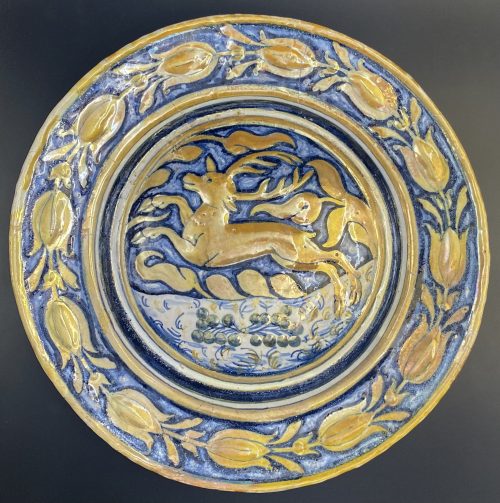 Tin-glazed earthenware plate with lustre in blue and ochre, decorated in relief with a deer in the centre and a chain of tulips on the lip; base signed “CK” in blue. Restored. Diameter: 24.8 cm; Height: 2.5 cm. Attributed to Gubbio (Umbria, Italy), 1520-1550.
Tin-glazed earthenware plate with lustre in blue and ochre, decorated in relief with a deer in the centre and a chain of tulips on the lip; base signed “CK” in blue. Restored. Diameter: 24.8 cm; Height: 2.5 cm. Attributed to Gubbio (Umbria, Italy), 1520-1550. -
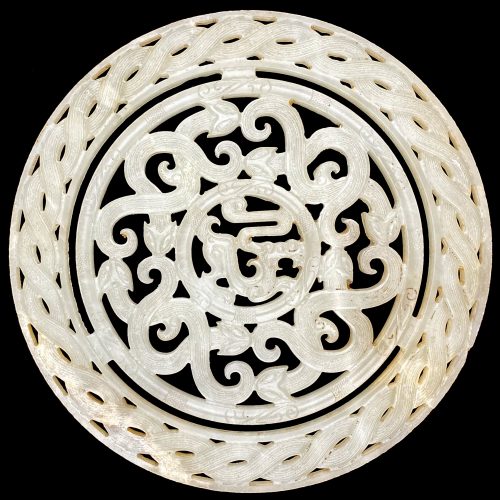 White jade Bi of three concentrical circles: double helix outer, intertwined serpents in the middle and a dragon in centre, carved in openwork and low-relief. China, the Ming Dynasty [大明] (1368 – 1644). Diameter: 15.9 cm; Height: 0.5 cm.
White jade Bi of three concentrical circles: double helix outer, intertwined serpents in the middle and a dragon in centre, carved in openwork and low-relief. China, the Ming Dynasty [大明] (1368 – 1644). Diameter: 15.9 cm; Height: 0.5 cm. -
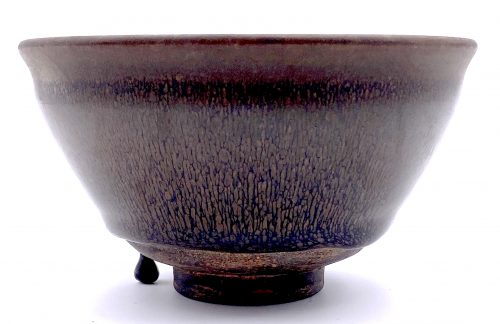 Brown bowl with golden-brown streaks on a black ground, mouth with a curved profile. A drop of glaze hanging in support. Base unglazed. In a wooden box. China, the Song dynasty [宋朝] (960 – 1279). Diameter: 12.5 cm; Height: 7 cm.
Brown bowl with golden-brown streaks on a black ground, mouth with a curved profile. A drop of glaze hanging in support. Base unglazed. In a wooden box. China, the Song dynasty [宋朝] (960 – 1279). Diameter: 12.5 cm; Height: 7 cm. -
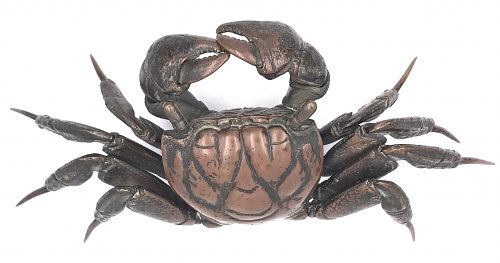 Jizai okimono bronze articulated model of a crab. Japan, Meiji period(1868-1912). Size: Body: 6.5 x 6 cm. Total: 23 x 11 cm. Weight: 762 g
Jizai okimono bronze articulated model of a crab. Japan, Meiji period(1868-1912). Size: Body: 6.5 x 6 cm. Total: 23 x 11 cm. Weight: 762 g -
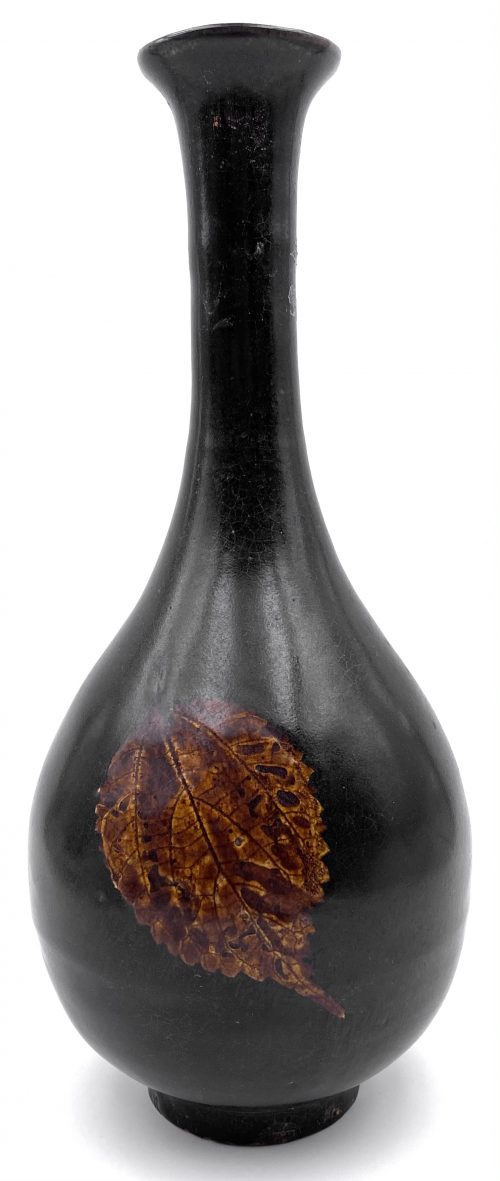 Jizhou black glaze bottle decorated with a leaf, placed on to the glaze before firing, and burnt away in the kiln to leave its pattern. Foot unglazed. China, the Song dynasty [宋朝] (960 – 1279). Height: 27.5 cm.
Jizhou black glaze bottle decorated with a leaf, placed on to the glaze before firing, and burnt away in the kiln to leave its pattern. Foot unglazed. China, the Song dynasty [宋朝] (960 – 1279). Height: 27.5 cm. -
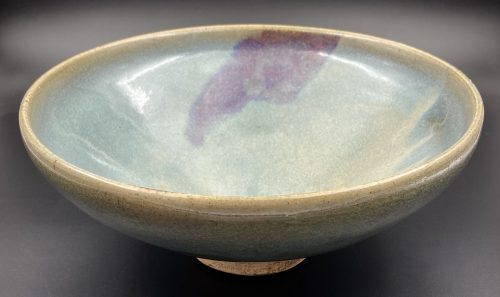 Bowl with tapered sides, lavender-blue glaze and a large purple splash on the interior; yellowish rim; foot unglazed. China, the Yuan Dynasty [大元] (1279 – 1368). Diameter: 21 cm; Height: 9 cm.
Bowl with tapered sides, lavender-blue glaze and a large purple splash on the interior; yellowish rim; foot unglazed. China, the Yuan Dynasty [大元] (1279 – 1368). Diameter: 21 cm; Height: 9 cm. -
 Circular form tsuba made by a mirror-maker, i.e. kagamishi. Cast yamagane plate with design of six persimmons on their peduncles surrounded by leaves. Slightly raised rounded square rim. Hitsu-ana is brutally cut later in time. Copper sekigane. Early Muromachi period (1393-1457) or earlier. The inscription on the box reads: "Kamakura or Muromachi Period. Yamagane Tsuba". Dimensions: 81.9 x 81.6 mm; thickness at seppa-dai 2.8 - 3.0 mm, rim 3.4 mm.
Circular form tsuba made by a mirror-maker, i.e. kagamishi. Cast yamagane plate with design of six persimmons on their peduncles surrounded by leaves. Slightly raised rounded square rim. Hitsu-ana is brutally cut later in time. Copper sekigane. Early Muromachi period (1393-1457) or earlier. The inscription on the box reads: "Kamakura or Muromachi Period. Yamagane Tsuba". Dimensions: 81.9 x 81.6 mm; thickness at seppa-dai 2.8 - 3.0 mm, rim 3.4 mm. -
 Iron tsuba of round form, on both sides decorated in low relief (kebori) with a dragon, eyes inlaid in brass. NBTHK: Hozon, № 4011013. Kamakura-bori type of tsuba. Med-Muromachi period, c. 1450. Diameter: 90 mm; Thickness (centre): 3.3 cm, Thickness (rim): 2.4 cm Reference: Japanese Swords and Sword Fittings from the Collection of Dr Walter Ames Compton (Part I). — NY: Christie's, 1992, p. 10, №2. Obviously, Compton's tsuba has an altered nakago-ana and placed on the photo upside down. Compton's tsuba has a raised mimi, while mine does not.
Iron tsuba of round form, on both sides decorated in low relief (kebori) with a dragon, eyes inlaid in brass. NBTHK: Hozon, № 4011013. Kamakura-bori type of tsuba. Med-Muromachi period, c. 1450. Diameter: 90 mm; Thickness (centre): 3.3 cm, Thickness (rim): 2.4 cm Reference: Japanese Swords and Sword Fittings from the Collection of Dr Walter Ames Compton (Part I). — NY: Christie's, 1992, p. 10, №2. Obviously, Compton's tsuba has an altered nakago-ana and placed on the photo upside down. Compton's tsuba has a raised mimi, while mine does not.
 Two other examples of the same design may be found at: (1) Christie, Manson & Woods auction sales “Kotetsu”, 1980, page 12, №10 and (2) Professor A. Z. Freeman and the Phyllis Sharpe Memorial collections №36, pp. 18-19. Both have raised mimi, the latter classified as Katchushi tsuba.
More about Kamakura-bori tsuba here.
Two other examples of the same design may be found at: (1) Christie, Manson & Woods auction sales “Kotetsu”, 1980, page 12, №10 and (2) Professor A. Z. Freeman and the Phyllis Sharpe Memorial collections №36, pp. 18-19. Both have raised mimi, the latter classified as Katchushi tsuba.
More about Kamakura-bori tsuba here.


